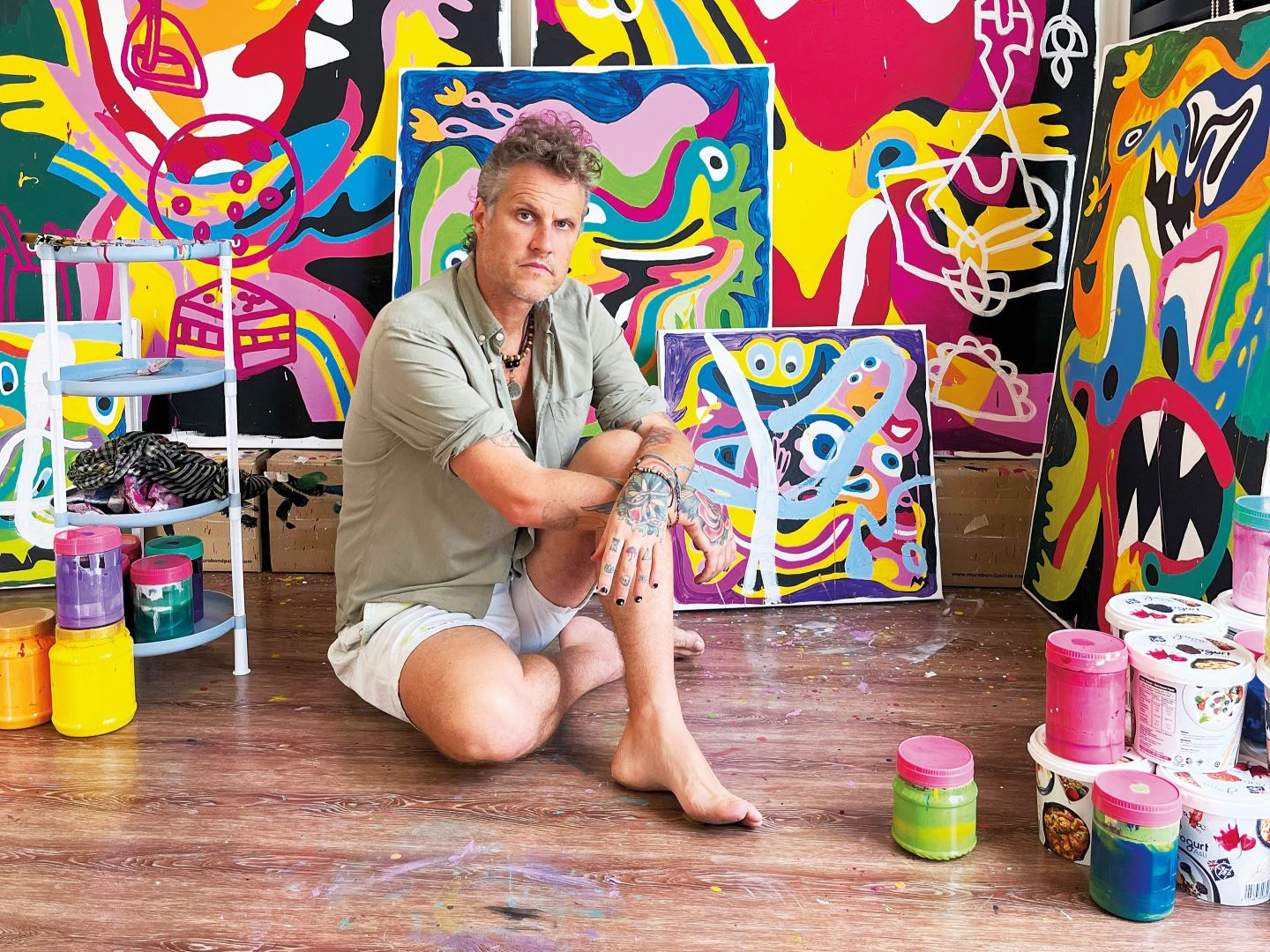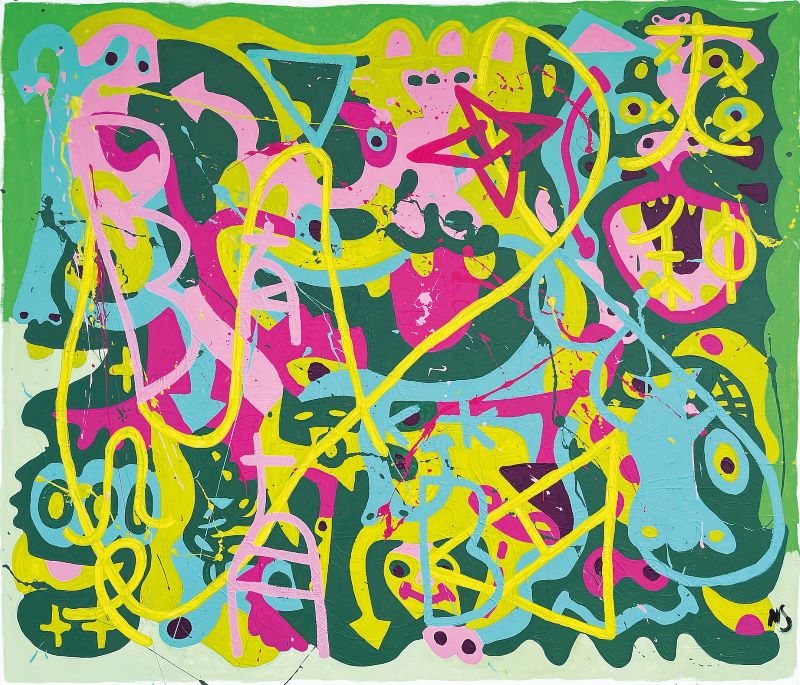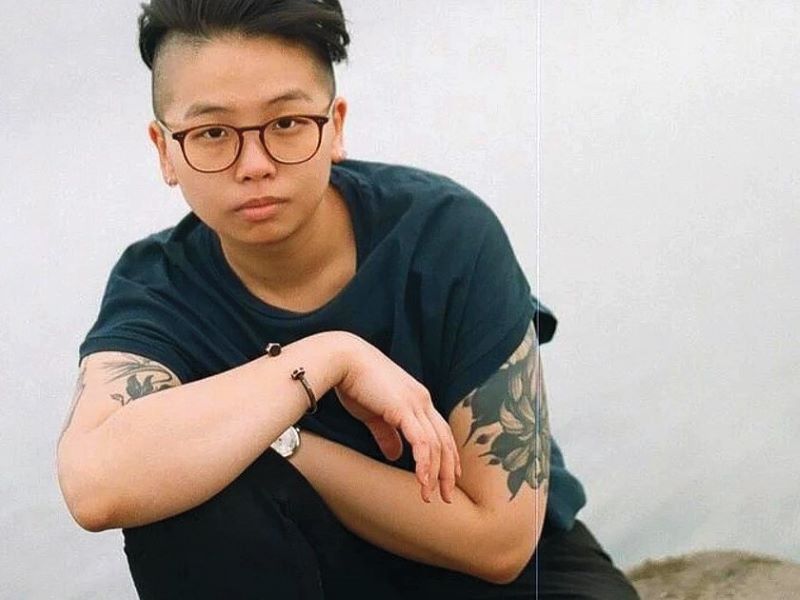
Sense: As I get older, I want my paintings to be more joyful and more about celebrating life (All photos: Zhan Art Space)
What is ordinary and routine to a local — people eating at a kopitiam, fruits on the street, bits of conversation caught in passing — stir Nigel Sense’s creative senses and find their way onto his canvas. Paintings born of what the Australian observed and heard around George Town, complemented with soundscape cues by Malaysian writer-director Jean Tong, make up Rojak, a cross-cultural artistic exploration that takes its name from colloquial Malay for “jumbled”.
The nomadic artist whose work centres around journeys and discovery, describes his current exhibition at Zhan Art Space in Petaling Jaya as “a love letter to travel”. He has a kindred spirit in Tong, who moved from Kuala Lumpur to Melbourne in 2011 and found people were so unlike her, “yet it was where I felt more like I belonged”.
Sense feels at home in Penang, “sitting near the wet market at Pulau Tikus in the morning and talking to everyone passing by … There’s something so romantic about it for me. I like the heat, the fans making a bit of noise, strong coffee and just listening to everything around me. All that goes into my painting.”
Pre-pandemic, he was traversing Malaysia to get to Thailand when he took the old ferry from the mainland to the island, fell in love with it and told his wife they should return and live there. The couple stayed on the road but, by end-2023, felt the time was right to “try it out and see what happens. We haven’t left since”.
Rojak, that “weird, wonderful and crazy” fruit-and-vegetable salad Penang is known for, was a bit sweet at first bite for this foreigner. But it grew on him the more he ate it. The same goes for travelling to a new place, Sense thinks. “Sometimes, it’s just about getting there. You keep doing it, you keep investigating, and then you start to really fall in love with where you are.”
The 48-year-old has been creating art professionally for 15 years and says he cannot not do it. He remembers being a four-year-old drawing in a corner, then the teenager who wanted to go to art school even though he was good at hockey. Eventually, he did creative arts at the University of Wollongong in his New South Wales hometown.
From India to Sri Lanka, Vietnam and now Malaysia, discovering lands informs his idiosyncratic style and work, which engages with vivid colours, layered textures, energy and humour. Abstract but immediate, his lines, dots, shapes, symbol and strokes lead viewers to uncover things they are familiar with. At Rojak, it could be a durian, Nyonya desserts, a bowl of soup, or even two strokes that bring to mind chopsticks.
rojak_borneo_monkey_park.jpg

“There are some recurring things, such as movement or maps. I usually have a lot of arrows because I’m always like, ‘Where can we go?’ We’re always looking to the next place we want to see or experience.
“I’ve been here almost two years and things have really seeped into my artistic process and everyday life. But they’re a bit concealed — you need to work to see what I’m hiding within the painting.”
What has been obvious for some time now, Sense adds, are the little quirky masks and figures on his canvas. “It’s kind of like a selfie; I’m putting myself into the work a little. And I do like using bright colours, probably because I have only 35% vision in my right eye. I love bright art because I can see it from a distance. And as I get older, I want my paintings to be more joyful and more about celebrating life.”
Another signature is the white space on the edges of his canvas. He leaves them empty to draw the eye to the material and is tickled when viewers ask if he ran out of paint.
“Canvases come in different colours from different countries. I never buy them online. I have to look at it, touch it and feel the coarseness. I like celebrating that rawness.”
Rojak is his first collaboration with Tong, who started by delving into some catalogues of Sense’s art to see what she connected with before bringing in the soundscapes, which were produced by Australian musician James Gales. Through conversations, they then considered how their different practices, writing versus painting, could add to the visitor’s overall gallery experience.
img-20250319-wa0004.jpg

“I found Nigel’s work to be a condensed, abstracted vision of what he finds before him. He distils the vastness of any moment — mundane, funny, tragic, beautiful — into a single frame that allows you to project your own sense of self onto it,” Tong says.
“As a playwright and screenwriter, I do almost the opposite. I seek out moments that can be explicitly verbalised between people. So, in response to his finished pieces, I looked to generate scenes based on the dramas I could find in the intersections of his paintbrush, his titles and, sometimes, even the text in his paintings.”
Visitors at their show can expect “a full-body experience” unique to them. There will be enough details so they will not feel as if they are listening to purely background music, but abstract, too, so the individual has space to inject his own experience into it.
“The conversation between the paintings and soundscape is not overt,” Tong says. “It rewards repeat listening and viewing, offering surprise links between dialogue and visuals, in some cases, and enhancing the emotions you might feel looking at a painting, in others.”
A traveller herself, she believes place can shape the kind of person we are. “The ways our lives fit in, or don’t, with the environment around us deeply influence the decisions we make. Travelling reminds me of the importance of community, and how our work must always respond to the specificity of where we are, because it is shaped by and shapes the context around us.”
Being able to view her own world from a distance while observing how the Aussies interacted with theirs helped her better understand the variable influences that make us who we are and, therefore, how to become who we want to be, she thinks.
Tong grew up in PJ and left to study in Australia at 16. The biggest influence on her life was her parents having, quite deliberately, “zero-to-no influence” on her career, she says. As a child who always had her nose in a book, she meandered through a Literature degree, which led to writing for theatre and then working in TV. She has written for shows such as Heartbreak High (Season 2 on Netflix), and weird, political plays like Hungry Ghosts, which premiered at the Melbourne Theatre Company (MTC) in 2019.
A common theme in all of her writing is a deep hope that “we can imagine a world of radical acceptance and justice. My work often investigates why we’re so prone to creating an ‘other’ that we can demonise and fear, and asks how we can begin to create understanding instead”.
In contrast, as a director, she helps writers communicate their vision by presenting it in ways that illuminate the meaning of their words so that audiences can fully grasp those ideas. “Both of these things, I think, get to the heart of why we make art at all — to understand and be understood.”
Equally important is helping those who are different to feel seen. “Sometimes, the job of art is to communicate reality as we personally see and experience it, to create spaces and visions of the world where those who are different are celebrated as equal. So, yes, I want to fuel change, but I think my job is to present a vision that we have the capacity to be better, and that [such a] world isn’t scary or bad, but entirely possible.”
Come October, Tong will be directing the world premiere of Australian author and broadcaster Benjamin Law’s adaptation of Dying: A Memoir, based on Cory Taylor’s book about a terminal illness diagnosis, for MTC. Her lips are sealed because of media embargoes on publicity. But ask her about rojak and she says, “Love it. My favourite is pasembur, Indian rojak, specifically the stall in SS2, PJ.”
Rojak runs at Zhan Art Space, The School, Jaya One, PJ, until April 27. For enquiries, call (012) 291 4053.
This article first appeared on Mar 24, 2025 in The Edge Malaysia.


